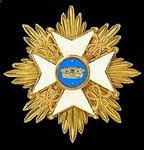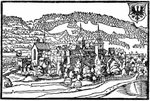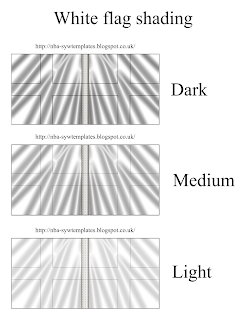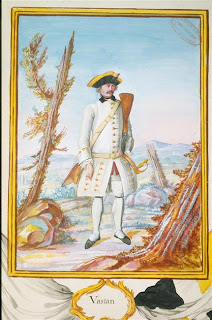UPDATE 13th January 2014: As people are likely to have missed my latest comment here it is:
Well, here we are in a grey and dismal January - and I've had plenty of
time to consider where to go with the grey shading on the flags. I've
decided on a classic compromise (which used to be a British tradition).
I'll tone down the grey, probably to somewhere between medium and light.
I'll need to experiment. And as FB said, people can always print the
flags out lighter anyway.
Cheers,
David.
Der Alte Fritz has posted a comment on my latest flags, those of the French regiment Provence, asking me to tone down the grey shading as he thinks it too strong and that there should be "a more subtle transition from the basic white color". I'd be interested to know what others think on this as I've been trying various strengths of grey shading on the white areas of the flags and on the completely white flags, as some people may have noticed.
I've been vaccillating over what works best. Lately I've preferred the darker shading as it seems to me that, especially on a flag that will be around 3-4cms square in use, a more subtle shading will simply not show too well at all. And as you can see if you put "white flag" into Google images, in the real world it very much depends on a subtle and complex combination of light and material how dark the shadows in white flags look. A thick material in bright sunlight can have very dark shadows whereas a light material in bright sunlight will probably often have light shadows as much of the light travels through it rather than leaving surface shadows. And so on. (As 18th century French infantry flags were of thick pieces of silk taffeta sewn together I suspect they would show dark shading in bright light.)
So, I'd like to know what people think; do lighter greys work better than dark on these white wargames flags? I've posted an image here showing 3 different levels of shades of grey on a white French flag to give an idea of possible variations and to help people see those variations in contrast to each other.
Cheers,
David.
Thursday, 5 December 2013
Shading white flags; a question of greys...
Posted by
David Morfitt
at
Thursday, December 05, 2013
16
comments
![]()
Rossbach French Flags Project - Regiment Provence
First raised as a regular French unit in 1674, Provence had 2 battalions. It was at Hastenbeck and then Rossbach, where it was brigaded with Poitou Infantry and suffered heavy casualties, including its colonel seriously wounded. At Rossbach it was second in the centre (reserve) column behind Poitou. In 1758 it was at Krefeld but not engaged. In June 1759 a battalion of the regiment was attacked in its post at Erbefeld by troops of the Prince of Brunswick and driven back, with some men killed and wounded and 92 taken prisoner. However, it retreated in good order. In 1761 it was at the battle of Vellinghausen and fought well but suffered heavy casualties. Its final battlefield appearance of the war was at Wilhelmstahl in 1762. [Details from Kronoskaf and C. Duffy's Prussia's Glory.]
The flags as depicted were carried by this regiment from 1675 to 1780.
And this plate shows the uniform and flags in 1757:
Posted by
David Morfitt
at
Thursday, December 05, 2013
7
comments
![]()
Monday, 25 November 2013
Rossbach French Flags Project - Regiment Beauvoisis
The flags as depicted were carried by this regiment from 1685 to 1791.
And this plate shows the uniform and flags in 1757:
Posted by
David Morfitt
at
Monday, November 25, 2013
6
comments
![]()
Sunday, 24 November 2013
Rossbach French Flags Project - Regiment Rohan-Montbazon
First raised in 1634, Rohan-Montbazon had 2 battalions. The regiment was at Rossbach (brigaded with Beauvoisis Infanterie), and was the third regiment in the centre column (the reserve) behind Provence and Poitou infantry regiments. It suffered heavily, losing 11 officers killed and 18 wounded. At Sandershausen in 1758 the regiment was battered by the Hessian attack, and, having used up all its ammunition, had to resort to the bayonet. Casualties were very heavy; 66 officers and 778 men were killed or wounded. At Lutterberg later that year the regiment was luckier and little engaged. In January 1759 it was involved in the relatively bloodless coup that seized the city of Frankfurt, which the French then held for the rest of the war. At Bergen in April 1759 along with Piemont and Royal Roussillon the regiment drove the allies back with the bayonet. In the last few years of the war the regiment garrisoned the Channel coast. [Details from Kronoskaf and C. Duffy's Prussia's Glory.]
The flags as depicted were carried by this regiment from 1745 to 1759.
And this plate shows the uniform and flags in 1757:
Posted by
David Morfitt
at
Sunday, November 24, 2013
4
comments
![]()
Friday, 22 November 2013
Rossbach French Flags Project - Infantry Regiment Cossé Brissac
First raised in 1674, Cossé Brissac Infanterie had 2 battalions and in 1757 was part of Soubise's Army of Saxony. The regiment was at Rossbach, brigaded with the St Chamond regiment. Cossé Brissac was in the left hand column of the three infantry columns just behind St Chamond; it was also badly mauled and its colonel was wounded and taken prisoner. The depleted regiment was sent back to France to reform and from 1758-61 was on the coast of Brittany. From 1761-2 it was in Germany. From 1762 it was renamed after the province of Vivarais.
The flags of this regiment are very confusing - not to mention somewhat hallucinogenic in appearance! Although the four colours in each quarter are recorded in e.g. the État Général of 1753, their actual placement is not clear. Every modern version I have seen differs, so I have decided to use the contemporary depiction on the 1757 manuscript, as shown below. Contemporary does not always mean correct, of course, but in this case I prefer this version - it also seems more convincing to me.
And this plate shows the uniform and flags as depicted in 1757:
Posted by
David Morfitt
at
Friday, November 22, 2013
4
comments
![]()
Tuesday, 19 November 2013
Rossbach French Flags Project - Regiment St Chamond (or Chamont)
This is the first of the Rossbach French infantry flags.
First raised in 1629, St Chamond (or St Chamont (as on the 1757 plate) or St Chamant) had 2 battalions and in 1757 was part of Soubise's Army of Saxony. The grenadier company distinguished itself in the chaotic fracas at Weissenfels 31st October 1757, helping to cover the retreat of the Bavarian and Palatinate troops from the town across the bridge and delaying the pursuing Prussians while the bridge was fired, and then escaping across it before the bridge took fire. (Christopher Duffy gives a good account of the action in his book Prussia's Glory, pp.56-59. It seems from his account that it may have been an officer or officers of this regiment stationed on an island in the river who spotted Frederick reconnoitring the burning bridge and who reported to their commander the Duc de Crillon that it would be easy to pick him off from there. de Crillon told them they were there simply to observe the destruction of the bridge and "not to kill a general who was on reconnaissance, let alone the person of a king, which must always be held sacred". How different the course of the war and European history would probably have been if he'd said "go ahead and do it"!) The regiment was at Rossbach, brigaded with the Cossé-Brissac regiment. St Chamont was in the left hand column of the three infantry columns just behind Piémont which was in the lead and suffered heavily there, losing 400 men and having its colonel wounded. For most of the rest of the war the regiment was in France, recuperating and after that manning the coast of Normandy and then Belle-Isle.
The flags as depicted were carried by this regiment from 1749 to 1762.
And this plate shows the uniform and flags in 1757:
Posted by
David Morfitt
at
Tuesday, November 19, 2013
2
comments
![]()
Monday, 11 November 2013
New - Coming Soon - Rossbach French Infantry Flags Project - and what about future uniform templates?
As I've nearly completed all the French infantry flags from Minden which I planned to do I thought I'd continue the focus on the French by starting a little project to do most of the French infantry flags from Rossbach. It was certainly not one of the glory days for the French army but one pleasant advantage of this project for me is that instantly some are done already, as a few regiments at Minden were also at Rossbach! Rossbach also gives me chance to draw some of the Swiss infantry flags, which I particularly like and which have not featured on this blog before. If I find the energy and time I may even do some of the German French infantry flags, which on the whole are rather more complex and elaborate than those of the native French infantry so require much more work. I've so far avoided doing those for Minden, as some of you may have noticed.
I've also been thinking about possible new uniform templates. I've not done any for a long time, having lacked the inspiration, time and energy. If anyone has any ideas for templates they'd like to see then please leave your suggestion(s) and I'll see what's possible or tickles my interest. I won't promise to do all those suggested but it will help if you give me some ideas. Thanks!
[Update Sunday 17th November: Well, it seems that at the moment there's no interest in new uniform templates! That saves me some work, anyway... ]
Posted by
David Morfitt
at
Monday, November 11, 2013
10
comments
![]()
Wednesday, 6 November 2013
The NOT-Minden French Flags Project - Regiment Normandie
The NOT-Minden French Flags Project is an extension of the Minden French Flags Project which allows me to do other French flags of the SYW, especially now I have done all the easier and less complicated flags of the French infantry at Minden, and, like today, feeling weary late on a Wednesday evening, want an easy flag to post to keep things ticking over...
And so back to Regiment Normandie:
First raised in 1574 as the Bandes de Normandie which were created from the Vieilles bandes françaises, this was one of the six Vieux Corps and had 4 battalions. The regiment was in garrison from 1757-1760 in Ostende and then various places in Artois. From 1760 it served with the army of Maréchal de Castrie; in October that year it was at the battle of Clostercamps where it initially distinguished itself but while in pursuit over open ground was counter-attacked by British cavalry and lost a flag. In 1761 it was at the battle of Vellinghausen but took no part in the action. At the end of that year it returned to France to guard the coast of Normandy.
The flags were as depicted from 1616 to 1791:
And this plate shows the uniform and flags in 1757:
Posted by
David Morfitt
at
Wednesday, November 06, 2013
2
comments
![]()
Sunday, 6 October 2013
Minden French Flags Project - Regiment Aquitaine
Incorporated in the French army in 1625, although traditionally dating from 1604, this regiment was named Anjou in honour of the Duke d'Anjou in 1671 and then renamed Aquitaine in 1753. This was a two battalion regiment and gave its name to the brigade which also included the two battalion Vastan Regiment. The regiment was at Hastenbeck, the expedition against Zell (Celle), Krefeld, Minden, Sachsenhausen, Vellinghausen and Wilhelmstahl. At Minden it was in the first line of Guerchy's Division of left wing infantry and along with Auvergne distinguished itself.
The flags were as depicted from 1753 to 1772.
And this plate shows the uniform and flags in 1757 (with the blue on the Ordonnance flag shown much lighter than is generally the case):
Posted by
David Morfitt
at
Sunday, October 06, 2013
8
comments
![]()
Saturday, 31 August 2013
Minden French Flags Project - Grenadiers Royaux
In April 1745 all militia grenadier companies were ordered to be detached from their parent battalions and grouped into 11 regiments of Grenadiers Royaux. Each regiment consisted of a single battalion. In January 1746 a decree stipulated that there would be a new company of grenadiers in each militia battalion, called Grenadiers Postiches. At the beginning of the Seven Years War the Grenadiers Postiches were detached from their parent militia battalions and incorporated into the 11 existing Grenadiers Royaux regiments, increasing them from 1 to 2 battalions each.
Grenadiers Royaux regiments wore the same uniform, distinguished only by different coloured collars and epaulettes on the right shoulder. All wore the tricorne laced silver.
Information summarised from Kronoskaf and the histories of the different regiments can be found at Kronoskaf here: http://www.kronoskaf.com/syw/index.php?title=French_Army#Militias
Each regiment carried only ordonnance flags as shown below:
And this plate shows the uniform and flags in 1757:
Posted by
David Morfitt
at
Saturday, August 31, 2013
18
comments
![]()
Saturday, 13 July 2013
Minden French Flags Project - Regiment Piémont
First officially raised 1569 although dating from much earlier, Piémont counted as one of the six regiments known as Vieux Corps. This was a four battalion regiment and gave its name to the brigade which also included the two battalion Dauphin Regiment. The regiment was at Rossbach, Lutterberg and Bergen as well as Minden. At Minden it was in the first line of Broglie's Corps. This was a famous unit whose performance in the Seven Years War was generally disappointing.
The flags were unchanged from 1569 to 1791. The simple flags of this and the other ancient French regiments illustrate the heraldic principle that simpler usually means older!
And this plate shows the uniform and flags in 1757:
Posted by
David Morfitt
at
Saturday, July 13, 2013
8
comments
![]()
Monday, 1 July 2013
Minden French Flags Project - Regiment Champagne
First raised 1558 and counted as one of the Petits Vieux regiments. This was a four battalion regiment so was the only unit in the Champagne Brigade. The regiment was at Hastenbeck, Krefeld, Bergen, Minden, Langensalza and Wilhelmstahl. At Minden it was in the first line of the left wing infantry.
The flags were unchanged from 1569 to 1791.
And this plate shows the uniform and flags in 1757:
Posted by
David Morfitt
at
Monday, July 01, 2013
5
comments
![]()
Tuesday, 11 June 2013
Minden French Flags Project - Regiment Du Roi
First raised 1663 and counted as number 6 of the Petits Vieux regiments. The king was the colonel of the regiment but it was in practice commanded by the colonel-lieutenant, who from 1745 was Claude Louis François de Régnier, Comte de Guerchy. This was a four battalion regiment so was the only unit in the Du Roi Brigade. The regiment was at Hastenbeck, Krefeld, Minden, Corbach, just missed Warburg and was at Vellinghausen. At Minden it was in the first line of the left wing infantry.
The motto Par Decori Virtus was added to the flags in 1753.
And this plate purports to show the uniform and flags in 1757; again, the flag appears to be incorrect for this date, showing that contemporary images can often be wrong!:
Posted by
David Morfitt
at
Tuesday, June 11, 2013
2
comments
![]()
Monday, 13 May 2013
Minden French Flags Project - Regiment Condé
First raised 1644 and re-raised 1659 after being twice disbanded during the Fronde Civil War. This was a two battalion regiment. The regiment was at Rossbach, Halberstadt, Quedlinburg and Krefeld as well as Minden. At Minden it was in the first line of the left wing infantry as the senior regiment of the Condé Brigade, which also included the 2 battalion Enghien Regiment (already depicted below). On the extreme left of the French position at Minden it was badly mauled by the attacks of the Hanoverian troops and afterwards was sent to garrison Cassel.
The same pattern of colours as shown here was carried from at least 1659 to 1791.
And this plate shows the uniform and flags in 1757 - but with mysteriously different flags from all other sources:
Posted by
David Morfitt
at
Monday, May 13, 2013
6
comments
![]()
Sunday, 28 April 2013
Minden French Flags Project - Regiment Vastan
First raised 1674. This was a two battalion regiment. At Minden it was in the first line of the left wing infantry as part of the Aquitaine Brigade, with the senior two battalion Aquitaine Regiment. It suffered heavy casualties at Minden; its colonel Aubery Marquis de Vastan was wounded and taken prisoner. The remainder of the regiment was sent back to France to be rebuilt and returned to Germany in 1761. On the 3rd October 1761 one entire battalion was captured at its camp at Oëlper near Brunswick in an attack led by Prince Ferdinand of Brunswick and Colonel Lückner, losing 250 men wounded and killed. Vastan himself was killed in the action. This was clearly an unlucky regiment! The remains of the regiment were then given to Marquis de Bouillé. It was renamed after the province of Vexin in 1762.
It seems likely the same pattern of colours as shown here was carried from at least 1749 to 1791.
And this plate shows the uniform and flags in 1757:
Posted by
David Morfitt
at
Sunday, April 28, 2013
3
comments
![]()
Friday, 19 April 2013
Minden French Flags Project - Regiment Enghien
First raised 1706 for Louis de Bourbon, duc de Bourbon, duc de Montmorency (1668–1689) duc d'Enghien (1689–1709), 6th Prince of Condé, comte de Sancerre (1709–1710), comte de Charolais (1709) (titles from his biography at http://en.wikipedia.org/wiki/Louis_III,_Prince_of_Cond%C3%A9). On his death in 1710 it remained without an owner until 1788. This was a two battalion regiment which served at Hastenbeck and Krefeld as well as Minden. At Minden it was in the first line of the left wing infantry as part of the Condé Brigade, with the senior 2 battalion Condé Regiment.
It seems likely the same pattern of colours as shown here was carried from 1706 to 1791.
Unfortunately I have no 1757 illustration of these flags and the uniform. Basically the regiment probably had red cuffs with 5 pewter buttons, all else being French off-white until 1761 when it acquired a red waistcoat and collar; the pockets were double vertical ones with 5 pewter buttons.
P.S. I had fairly complicated sinus/polyp/nasal septum surgery on the 4th April and am really only now starting to feel properly recovered so I may be even slower than usual posting further flags etc.. This flag is on account for the moment! One sadly does seem to take much longer to recover from these things as one ages...
Posted by
David Morfitt
at
Friday, April 19, 2013
2
comments
![]()
Sunday, 24 March 2013
Minden French Flags Project - Regiment Auvergne
Posted by
David Morfitt
at
Sunday, March 24, 2013
4
comments
![]()
Saturday, 16 March 2013
Minden French Flags Project - Regiment La Marche Prince
First raised 1684 and originally named after the province of Nivernais, this was a single battalion regiment and at Minden formed a brigade on the right wing with the 2 battalion regiment Rouergue and single battalion regiment Tournaisis. The name was changed to Comte de la Marche in 1753 and to La Marche Prince in 1759. In 1776 the regiment became Regiment Conti and the ordonnance flag became entirely different. This one was carried from 1684 to 1776.
There is some debate about the distribution of colours on this flag; I have shown what I think is the most likely and pleasing of the possibilities. The 1753 "État général" volume simply says "2 Drapeaux, dont un colonel blanc & un d'ordonnance bleu, feuille-morte [dead leaf colour] and isabelle [coffee brown] par bandes dans les quarrés, & croix blanche", which does not help greatly, although taking it literally one might assume the quarters were coloured, from the top, blue, then dead leaf, then Isabelle!
UPDATE Th07.04.2022: The French 1721 Manuscript confirms this design for the flags; the regiment was then called Nivernois.
Unfortunately I have no 1757 illustration of these flags and the uniform. Basically the regiment probably had blue cuffs, all else being French off-white until 1761 when it acquired a blue waistcoat and collar; the pockets were horizontal with 4 copper buttons.
These flags complete the flags of the first line of the right wing infantry of the French army at Minden. Next will be Auvergne which formed a 4 battalion brigade in the second line of right wing infantry. The rest of the second line consisted of 3 French German regiments totalling 4 battalions. I haven't yet decided if I'll do the flags of French foreign infantry units at Minden as they're vastly more work; for now, I'll be doing just the French regiments so after Auvergne I'll be heading to the French left wing.
Posted by
David Morfitt
at
Saturday, March 16, 2013
5
comments
![]()
Saturday, 23 February 2013
Reported problem with "Contact Me" form on my blog
I've now had two people tell me that (and I quote from the second report) "your "Contact Me" widget blocks the left most several letters of each line of your text. It really makes the text hard to understand." Does anyone else have this problem? I cannot see it in either Firefox 19 or Internet Explorer 8; in both I
have no problem except that the right-hand side of the Contact Me form itself is
truncated but the blog text is fine.
If you do have a problem can you tell me what browser you are using on what OS and device (e.g. desktop computer, etc.) and with what settings, please?
Thanks.
David.
Posted by
David Morfitt
at
Saturday, February 23, 2013
10
comments
![]()
Minden French Flags Project - Regiment Tournaisis
First raised 1684, Tournaisis was a single battalion regiment and at Minden formed a brigade on the right wing with the 2 battalion regiment Rouergue and single battalion regiment Comte de la Marche.
The same pattern of colours was carried from 1684 to 1775.
Unfortunately I have no 1757 illustration of these flags and the uniform. Basically the regiment had red cuffs, all else being French off-white until 1761 when it acquired red waistcoat and collar; the pockets were horizontal with 5 copper buttons.
P.S. Flag plate updated 16.03.2013 - the original was lacking its pole retaining nails!
Posted by
David Morfitt
at
Saturday, February 23, 2013
2
comments
![]()
Thursday, 14 February 2013
Minden French Flags Project - Regiment La Marche
First raised 1684, La Marche was a single battalion regiment and at Minden formed a brigade on the right wing with the 4 battalion regiment Picardie. It was highly distinguished in its conduct at Krefeld where alone it tried to stop the Allied flanking attack and for almost three hours delayed the Allied assault.
The same pattern of colours was carried from 1684 to 1762, when the regiment was disbanded.
Unfortunately I have no 1757 illustration of these flags and the uniform. Basically the regiment had red cuffs, collar and waistcoat; until 1761 the coat had elaborate double vertical pockets.
[I can't help feeling that this is one flag where the usual French elegance fails; the colours make a horribly ugly and messy mix!]
Posted by
David Morfitt
at
Thursday, February 14, 2013
4
comments
![]()
Saturday, 9 February 2013
Request; photographs of my French flags in action, please.
I think I've spotted my French flags in action on a Russian wargamer's blog here: http://vasiliyl.blogspot.ru/2013/01/die-kreigkunst-deluxe-5-french-is-coming.html but otherwise have yet to see them in use. If anyone does use them for their French SYW army, can you let me have a link to a blog/website with pictures or send me photographs of them in action, please? (You can contact me via the contact form on the blog, in the left column.)
Thanks!
David.
Posted by
David Morfitt
at
Saturday, February 09, 2013
9
comments
![]()
Minden French Flags Project - Regiment Rouergue
First raised 1667, Rouergue was a 2 battalion regiment and at Minden formed a brigade on the right wing with the single battalions of La Marche and Tournaisis. It was badly mauled at Warburg in 1760.
The same pattern of colours was carried from 1671 to 1791.
And this plate shows the uniform and flags in 1757:
Posted by
David Morfitt
at
Saturday, February 09, 2013
2
comments
![]()
Friday, 25 January 2013
Minden French Flags Project - Regiment Talaru/d'Aumont
First raised 1673, this regiment began the SYW with the name Talaru but the name had recently changed to d'Aumont in January 1758. From December 1762 it was renamed Beauce after the province. (From 1673 when it was raised as d'Huxelles to Beauce 1763 it had altogether 10 different names.) A 2 battalion regiment, it was brigaded with Touraine at Minden (see previous entry below) where it was badly mauled. Its grenadiers wore the bearskin from 1753.
The same pattern of colours was carried throughout the regiment's history.
And this plate shows the uniform and flags in 1757:
Posted by
David Morfitt
at
Friday, January 25, 2013
4
comments
![]()
Thursday, 17 January 2013
Minden French Flags Project - Regiment Touraine
First raised 1624, Touraine was a 2 battalion regiment and at Minden formed a brigade with the 2 battalion Regiment d'Aumont. Touraine fought very well at the battle of Krefeld in 1758.
The same pattern of colours was carried from 1657 to 1791.
And this plate shows the uniform and flags in 1757:
Posted by
David Morfitt
at
Thursday, January 17, 2013
11
comments
![]()
Monday, 14 January 2013
Does word verification deter people from posting comments?
A while ago Bluebear Jeff said he found it difficult to read the word verification image to post a comment and so felt disinclined to write comments on my blog postings. I don't know if others have felt the same but for the past few hours I've switched off word verification as an experiment to see if it helps. I may not continue this indefinitely as I've already had to deal with 3 spam comments but if it appears to increase the number of comments posts receive I might do so. We'll see!
Posted by
David Morfitt
at
Monday, January 14, 2013
27
comments
![]()
Sunday, 13 January 2013
Minden French Flags Project - Regiment Belzunce
Belzunce was first raised in 1590. It was one of the Petits Vieux regiments which traced their origins to units first created in the 16th century. The regiment ranked 10th during the SYW.
The simple colours were carried from 1749-1762, after which the regiment changed its name to Flandres.
At Minden the regiment was 4 battalions strong and formed a brigade on its own which was in the first line alongside the Picardie Brigade.
And this plate shows the uniform and flags in 1757:
Posted by
David Morfitt
at
Sunday, January 13, 2013
2
comments
![]()
Thursday, 10 January 2013
Minden French Flags Project - Regiment Picardie
And here at last is the first of the Minden French Flags Project's flags; the colours of Regiment Picardie, one of the oldest and most prestigious regiments in the French army. First raised 1558, it ranked first after the Gardes Françaises and Gardes Suisses and was one of the six French regiments known as the Vieux Corps. It fought at Hastenbeck and Krefeld as well as Minden. The very simple colours remained the same from 1569 to 1791.
At Minden Picardie was 4 battalions strong and in the first line of the main army, brigaded with La Marche infantry. (The brigade was named Picardie; it was the French tradition to name brigades after the senior regiment in them.)
The print below shows the uniform and flags of Picardie infantry in 1757:
Posted by
David Morfitt
at
Thursday, January 10, 2013
4
comments
![]()









































.png)


















